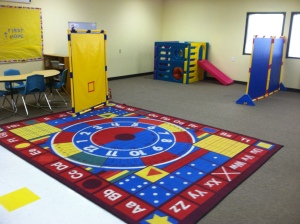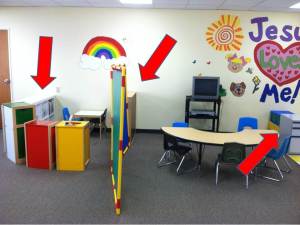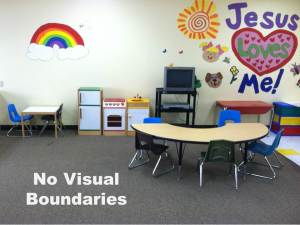 Establishing a supportive classroom for kids on the autism spectrum is an important component to consider when planning and designing a special needs classroom. Research has consistently indicated that the way the classroom is arranged influences the learning of individuals with autism. In addition, research has found that kids in organized and structured classrooms learn better and have fewer disruptive behaviors. Whether your learners are in an inclusive or a self-contained Sunday School classroom or any combination of locations, an organized classroom is key.
Establishing a supportive classroom for kids on the autism spectrum is an important component to consider when planning and designing a special needs classroom. Research has consistently indicated that the way the classroom is arranged influences the learning of individuals with autism. In addition, research has found that kids in organized and structured classrooms learn better and have fewer disruptive behaviors. Whether your learners are in an inclusive or a self-contained Sunday School classroom or any combination of locations, an organized classroom is key.
For those who have taught kids on the autism spectrum, you know that kids with autism may have difficulty gaining meaning from their activities, experiences, and/or environment. Participation may be limited due to a learner not understanding what is expected of him/her in a specific area of the classroom or during a Sunday School activity. An organized classroom with defined areas and spaces can assist a child/youth in anticipating the requirements of a specific setting and to predict what will be happening during Sunday School.
There are several key concepts to consider when organizing your special needs ministry classroom. I’m going to tackle just one of them today and it’s:
Create clear physical and/or visual boundaries to help learners know where each area begins and ends.
Segmenting the classroom helps clarify the expectations. Once learners are taught expected behaviors for each physical space in the classroom, the distinct areas become powerful cues for what’s expected. Visual boundaries may also help communicate to younger students, or those who are impulsive or motor-driven, where each area begins and ends and where they are supposed to be/stay in the classroom during specific activities. These boundaries are not intended to “contain” your kids, they are simply intended to exaggerate the cues about physical classroom spaces and expectations.
Here are the 3 steps that you’ll want to follow to structure the physical space in your classroom:
One, you need to identify the different areas that you would like to create in the classroom. I call these areas “intentional spaces.” Intentional space is “an area in your classroom that has a specific purpose.” The number of intentional spaces in a special needs ministry classroom can vary. The number can be influenced by how much physical space you have in your classroom and/or the number of activities that occur in your special needs ministry.
In the public school system many special education teachers create a variety of intentional spaces: for teacher directed activities (often individual desks), small and large group activities (i.e., small tables, carpet space on the floor), centers (i.e., reading corner, computers), and often small spaces for individual instruction or independent work if needed. Other intentional spaces may include areas to address leisure skills, vocational skills, self-help and self-management skills, and sensory development.
In our Special Friends Ministry at First Baptist Orlando we have the following intentional spaces:
- small group instruction
- large group instruction
- pretend play
- gross motor play
- cool down area
- sensory area
In some of our intentional spaces only one activity occurs. For example in our pretend play area the only thing that we do is enjoy, interact, and engage our kids in pretend play. However, in our small group instruction area we involve our learners in Scripture memory, Bible stories, prayer time, or an art/craft activity (these activities occur individually not simultaneously!).
 Two, you want to segment the different areas using visual boundaries. The types of boundaries used may vary. Visual boundaries can be created with the furniture found in your classroom, such as desks, shelves, filing cabinets, or tables, as well as with teacher-created materials such as fabric, cardboard table-top dividers, or masking tape. Note in the picture to the left, the use of furniture and dividers to create boundaries for the pretend food play and small group instruction spaces in the picture.
Two, you want to segment the different areas using visual boundaries. The types of boundaries used may vary. Visual boundaries can be created with the furniture found in your classroom, such as desks, shelves, filing cabinets, or tables, as well as with teacher-created materials such as fabric, cardboard table-top dividers, or masking tape. Note in the picture to the left, the use of furniture and dividers to create boundaries for the pretend food play and small group instruction spaces in the picture.
In times past, many public school classrooms for kids with special needs were sparse with large, empty spaces, and no visual boundaries. Educators discovered that this seemed to create the perfect environment for the students to wander around and/or get lost in their own sensory world. It was difficult for the student to know what to do because the environment made no sense to them. Would this type of environment make sense to you? Probably not. Here’s what the classroom looked like before using visual boundaries. You can see where it would kind of tough for some kids to see where the pretend play area ends and where the small group instruction area begins. 
Segmenting the different intentional areas using visual boundaries will support your learners in recognizing the purpose of each space and determine the beginning and ending of the space by simply encountering visual boundaries.
Three, the final step is to teach your learners how to move through the classroom space, and what the expectations are for each intentional space. This may involve pointing out the visual boundaries and visual cues to your learners and completing the activities in each intentional space with guidance if needed. This step may occur in only one Sunday for some of your learners, for others it will require several Sundays.
This above step also gives you a chance to evaluate the intentional spaces they have designed and determine if the visual boundaries are meaningful for your learners. If children/youth have continued difficulty following classroom expectations, you may decide that the organization of the classroom needs to be modified. For example, if you have placed colored tape on the floor to delineate a boundary in the small group intentional space, and the learner with ASD frequently peels off the tape, you may decide that the visual boundary is not meaningful and a bookshelf or divider may be more appropriate as the boundary.
I hope this article has helped you to think about the physical environment of the special needs ministry classroom. Please make sure that you subscribe to our blog or “like” our Special Friends Ministry facebook page to be notified when our next article is published.
Michael Woods, M.A. BCaBA CPI







July 12, 2012
Belonging, Inclusion Strategies, Preventing Behaviors